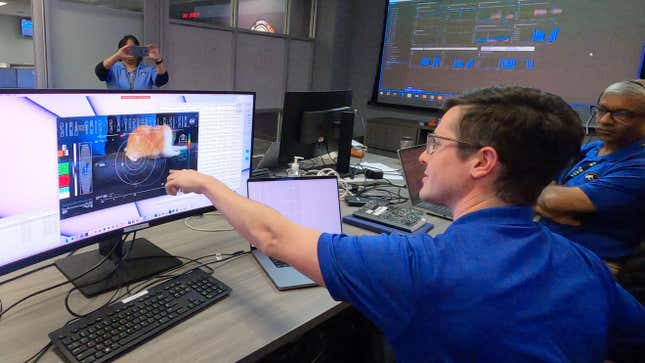NASA just combined all of my favorite things: space, lasers, and cats. In a first-of-its-kind demonstration of deep space optical communication, the space agency streamed a high-definition video from 19 million miles away from Earth. And as it turns out, NASA is just as obsessed as we are when it comes to sharing cat videos.
On December 11, a gold-capped laser transceiver attached to NASA’s asteroid probe Psyche beamed a 15-second-long video of an orange tabby cat named Taters chasing a laser pointer up and down a couch, the space agency revealed this week. The feline live stream broke the record for the longest distance covered by data-encoded laser beams—80 times the distance between Earth and the Moon—as NASA prepares to upgrade its communication skills for deep space missions.
The star of the video is actually the pet of a NASA employee. Footage of Taters is overlayed with graphics that illustrate several features from the technology demonstration, such as Psyche’s orbital path, and technical information about the laser and its data bit rate. It also displays more information about Taters, including its heart rate, color, and breed.
Advertisement
The video is not only so adorable that I could DIE, but it also demonstrated NASA’s ability to transmit data encoded in lasers from farther distances within deep space. We couldn’t think of a better video example to serve as the first high-definition stream sent via lasers from deep space.
Advertisement
NASA’s Deep Space Optical Communications (DSOC) experiment launched on board the Psyche spacecraft on October 13 as the first demonstration of laser, or optical, communications from as far away as Mars. In November, the instrument saw its first light and beamed data encoded within a near-infrared laser from nearly 10 million miles away from Earth.
Advertisement
For its latest demonstration, the laser transceiver beamed its encoded near-infrared laser to the Hale Telescope in San Diego County, California, at a maximum bit rate of 267 megabits per second. The video took 101 seconds to reach Earth, and each frame from the looping video was streamed live to NASA’s Jet Propulsion Laboratory (JPL) in Southern California, where the footage of Taters’ laser-chasing adventures played out in real time.

Advertisement
“Despite transmitting from millions of miles away, it was able to send the video faster than most broadband internet connections,” Ryan Rogalin, the project’s receiver electronics lead at JPL, said in a statement. “In fact, after receiving the video at Palomar, it was sent to JPL over the internet, and that connection was slower than the signal coming from deep space.”
Optical communication systems pack data into the oscillations of light waves in lasers, encoding a message into an optical signal that is carried to a receiver through infrared beams that the human eye can’t see. Although lasers have been used to transmit data from Earth orbit and the Moon, the recent test marks the farthest distance covered by the laser beams. “JPL’s DesignLab did an amazing job helping us showcase this technology—everyone loves Taters,” Rogalin added.
Advertisement
NASA normally uses radio waves to communicate with its missions that are located beyond the Moon, but near-infrared light packs data into significantly tighter waves, which allows for more data to be sent and received. The DSOC experiment aims to demonstrate data transmission rates 10 to 100 times greater than current radio frequency systems used by spacecraft today, according to NASA. Optical communications does become more challenging over longer distances as it requires extreme precision to point the laser beam.
“When we achieved first light, we were excited, but also cautious. This is a new technology, and we are experimenting with how it works,” Ken Andrews, project flight operations lead at JPL, said in a statement. “But now, with the help of our Psyche colleagues, we are getting used to working with the system and can lock onto the spacecraft and ground terminals for longer than we could previously. We are learning something new during each checkout.”
Related article: What to Know About NASA’s Unprecedented Psyche Mission to a Metallic Asteroid
The primary purpose of the Psyche spacecraft is to explore and study the unique metallic asteroid Psyche, providing insights into the history of planet formation and core dynamics. The farther away Psyche travels on its way to its asteroid target, the fainter the laser photon signal will become. Although the task is set to become more challenging, the team behind the experiment is still keen on having some fun with it.
Advertisement
“One of the goals is to demonstrate the ability to transmit broadband video across millions of miles. Nothing on Psyche generates video data, so we usually send packets of randomly generated test data,” Bill Klipstein, the tech demo’s project manager at JPL, said in a statement. “But to make this significant event more memorable, we decided to work with designers at JPL to create a fun video, which captures the essence of the demo as part of the Psyche mission.”
For more spaceflight in your life, follow us on X (formerly Twitter) and bookmark Gizmodo’s dedicated Spaceflight page.
Services Marketplace – Listings, Bookings & Reviews